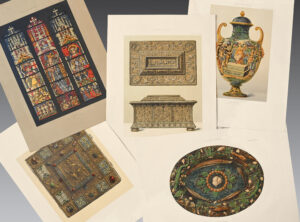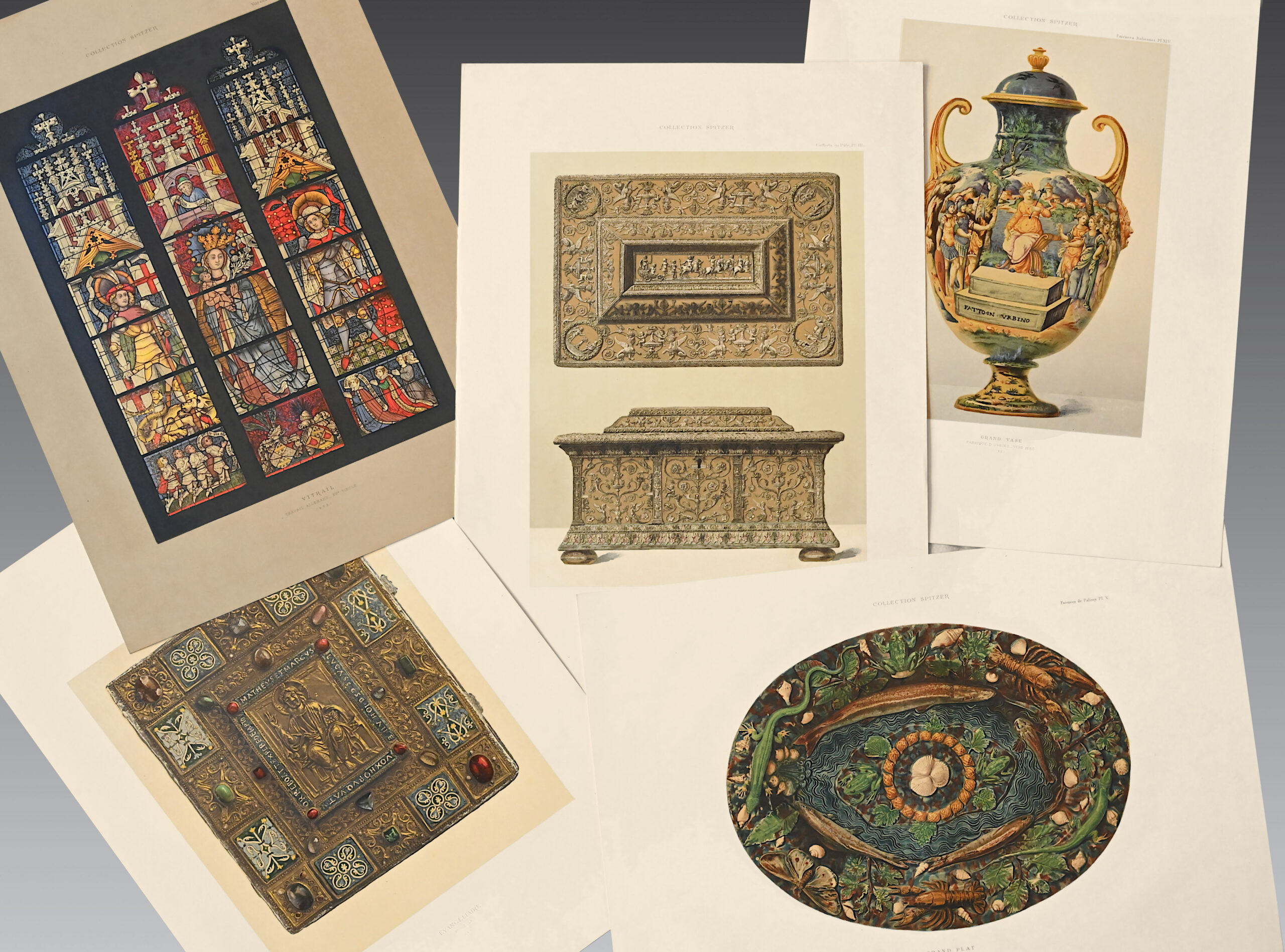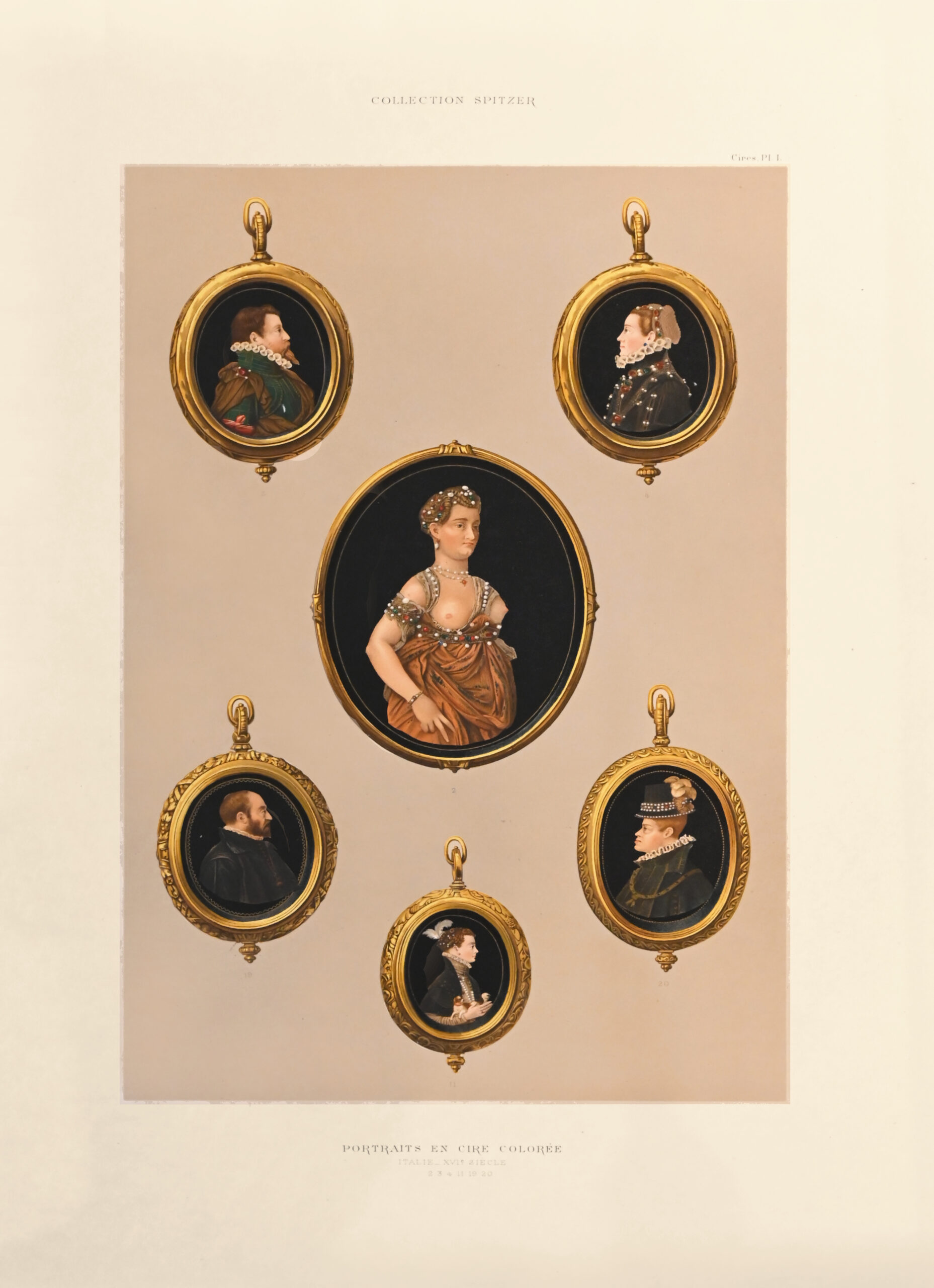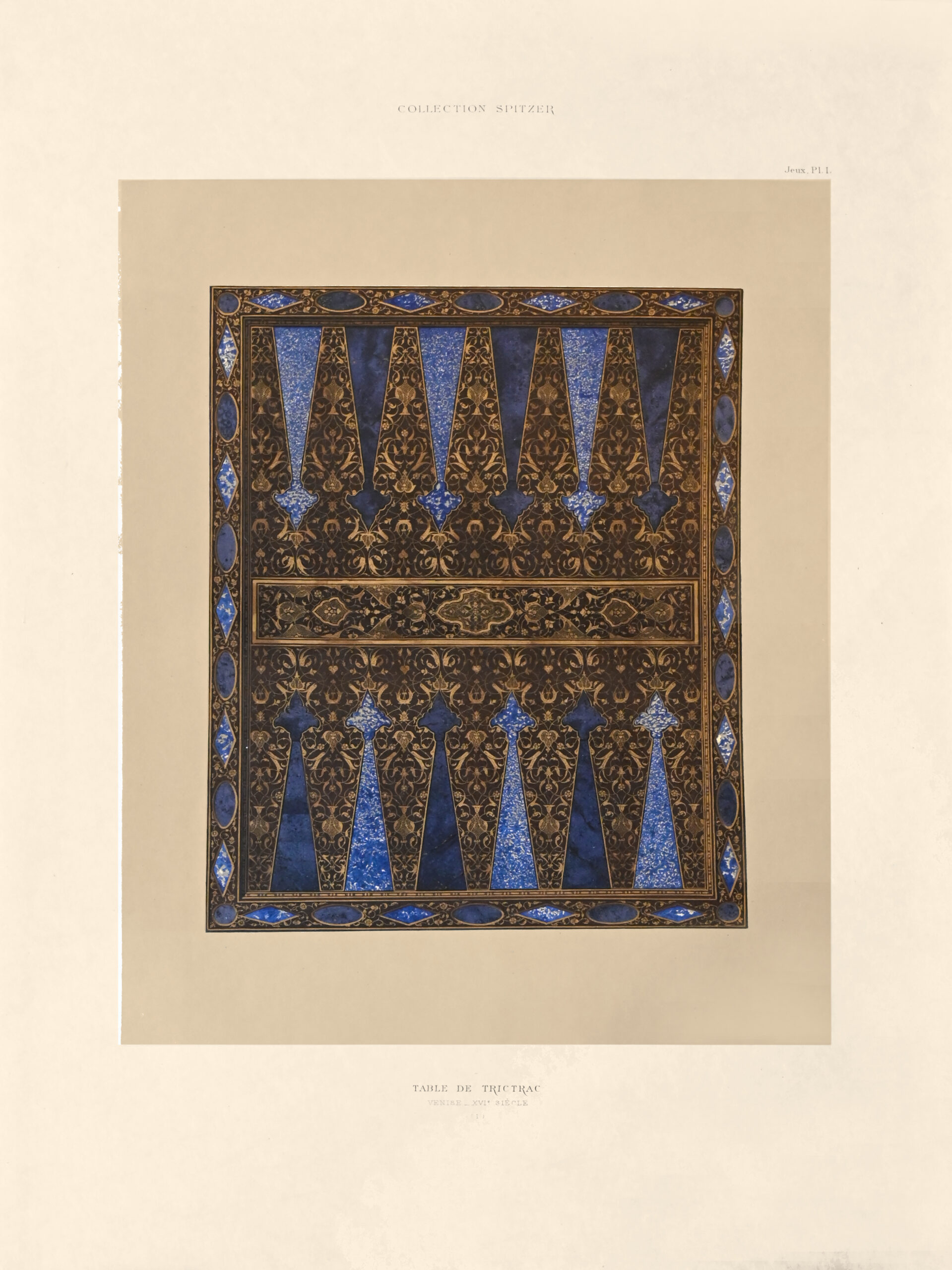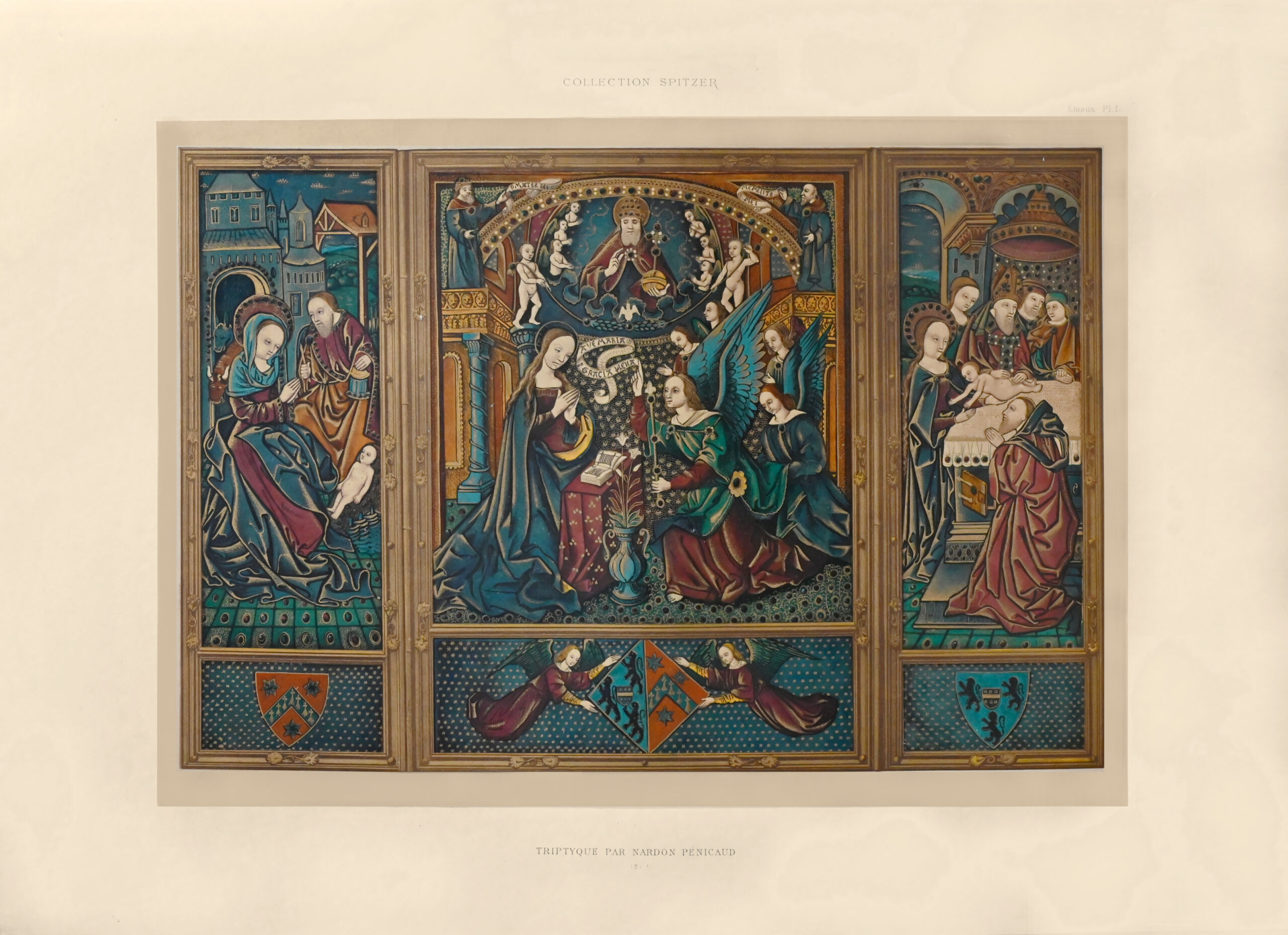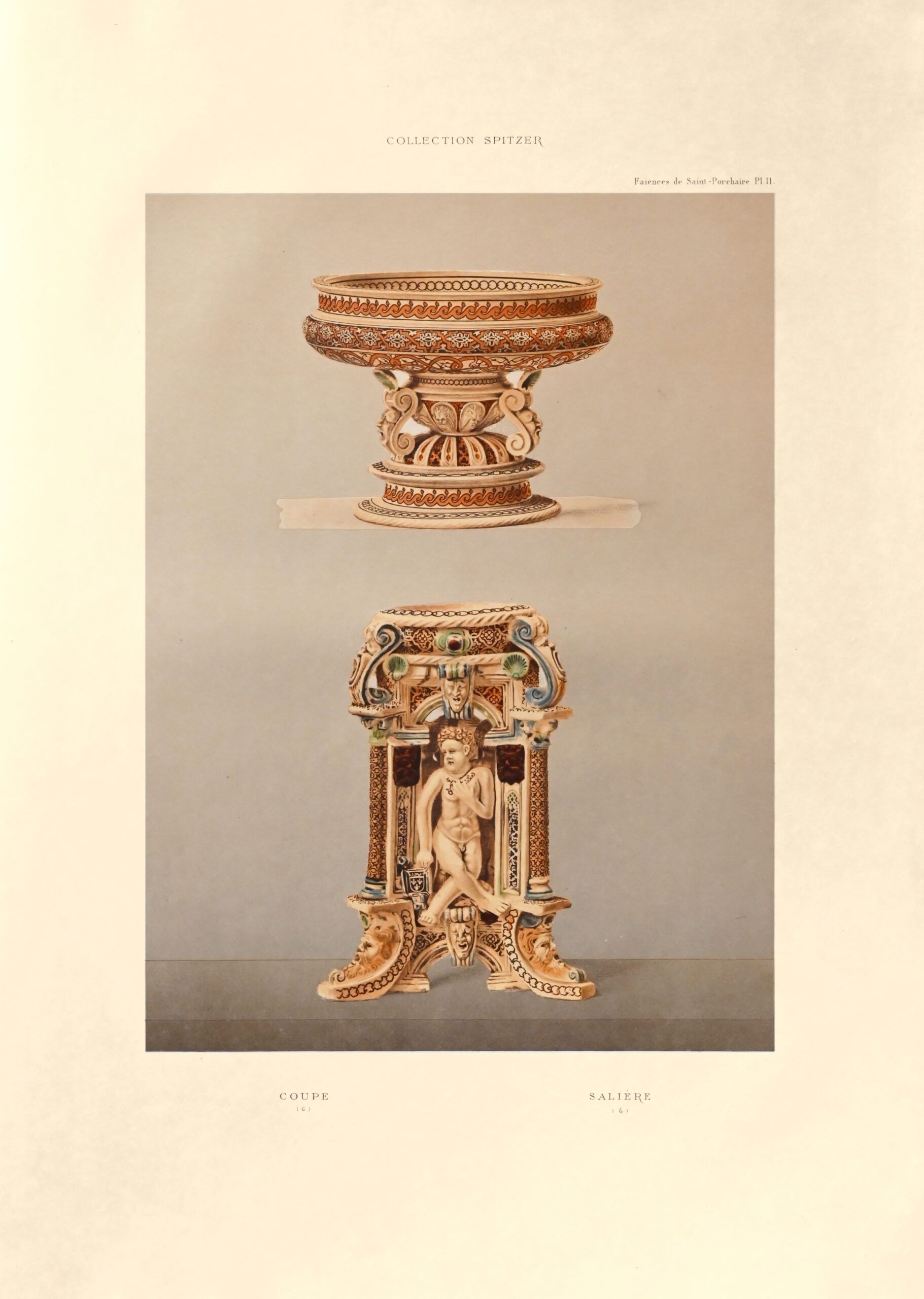Paris, Maison Quantin & Librairie Centrale des Beaux-Arts – A Londres, M. M. Davis, 1890 [Part I], 1891 [Parts II & III], 1892 [Parts IV-VI],
6 large folio volumes preserved unbound in publisher’s folders.
Illustrated with 342 out-of-text plates printed in chromolithography, heliotype, collotype, etc., many in color.
505 x 360 mm.
First edition of this monumental and superb catalogue of the Spitzer collection.
Copy n° 3, one of the 25 precious deluxe copies printed on Japan paper from an edition of 625.
Magnificently illustrated with 342 out-of-text plates printed in chromolithography, heliotype, collotype, etc., some enhanced with gold. Numerous in-text illustrations enhance the descriptions of the various art objects.
Frederic Spitzer (1815-1890) was a Viennese art collector and dealer who settled in Paris in 1852. His collection of works of art from the Middle Ages to the Renaissance, and the finesse of his knowledge, propelled him to become a dealer for great collectors such as Adolphe de Rothschild and Sir Richard Wallace.
Frederic Spitzer set about compiling a catalog of his collection (renamed the “Musée Spitzer” by his social circle) with the aim of “sharing his work with the whole world, thus bringing new and extremely interesting elements to the history of all the arts”.
“This name, relatively forgotten today, is that of a colorful man, a character such as only the 19th century could produce. It is also synonymous with an immense art collection. “Choosing the most exquisite things that art has created, the most admirable things that human industry has kneaded, filed, woven, forged, chiseled or cast, the famous amateur had formed a collection without rival, unique in Europe, and built a palace to house it.”
It was in these glowing terms that art historian Edmond Bonnaffé described the collection assembled by Frederic Spitzer (1815-1890), for which he wrote one of the six volumes paying tribute to him. Today, the collection is dispersed among the great national museums of the West, or is in private hands, and the numerous testimonies, as well as the plethora of works published on the subject, give an idea of what it might have represented.”
The 6 volumes cataloguing the Spitzer collection are divided into 35 sections listing objects by typology:
Vol. I : Antiques – 7 pl., Ivory – 24 pl., Liturgical silverware – 25 pl., Tapestries – 7 pl.
Vol. II : Painted enamels – 16 pl., Furniture and carved wood – 20 pl., Earthenware from Saint-Porchaire – 3 pl., Earthenware from Bernard Palissy – 7 pl., Locksmithing – 5 pl., Leathers – 6 pl.
Vol. III : Civil silverware – 15 pl., Metal inlays – 3 pl., Painting under glass – 2 pl., Glassware – 9 pl., Stained glass – 3 pl., Jewelry and rings – 7 pl., Stoneware – 4 pl., Cutlery – 5 pl., Boxwood and Munich stone sculpture – 11 pl.
Vol. IV : Italian earthznware – 22 pl., Hispano-Moorish earthenware – 2 pl., Sculpture – 22 pl., Plaquettes – 4 pl., Medals – 4 pl., Dinanderie – 2 pl.
Vol. V : Gems 10 pl., Clocks and watches – 8 pl., Mathematical instruments – 4 pl., Manuscripts – 6 pl., Miniatures and drawings – 2 pl., Waxes – 1 pl., Fabrics and embroideries – 14 pl. (with 11bis), Boxes – 3 pl., Games – 2 pl.
Vol. VI : Weapons – 57 pl.
“On April 23, 1890, as this volume went to press, the eminent collector Frederic Spitzer died… We do not pretend to add here one more tribute to the public tributes which have been paid to his memory; we must say only the part which belongs to him in this catalog, the publication of which he considered the crowning achievement of his career, and which was to be the complement of the incomparable museum which he had created. Not content with opening his galleries to all … Frederic Spitzer wanted the whole world to benefit from his work, bringing new and extremely interesting elements to the history of all the arts. It was from this generous concern that the idea of this catalog was born… Mrs. Spitzer, concerned about the future of the work to which her husband was so passionately attached, wanted his intentions to be scrupulously respected.” (Les Editeurs).
« Afin que ce livre fût un modèle du genre, [Frédéric Spitzer] fit appel à des historiens d’art d’une autorité reconnue, et il s’attacha à faire exécuter, de tous les objets de choix, des reproductions absolument fidèles. Tout a concouru, en un mot, pour faire du Catalogue de la Collection Spitzer non seulement un beau livre, mais encore un livre d’une utilité incontestable. »
(= “To make this book a model of its kind, [Frédéric Spitzer] called on the services of art historians of recognized authority, and endeavored to produce absolutely faithful reproductions of all the choice objects. In short, everything conspired to make the Catalogue de la Collection Spitzer not only a beautiful book, but also one of indisputable utility”).
Préface, Les Editeurs.
The entire collection comprised almost 4 000 objects, which were sold in 1893 by the Galerie Georges Petit (Paris) in 38 auctions. A second sale took place in 1895, specifically for weapons and armor.
A fine copy, complete with all the plates, preserved in the publisher’s folders.
